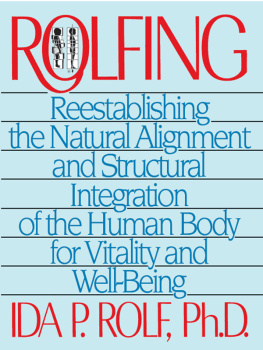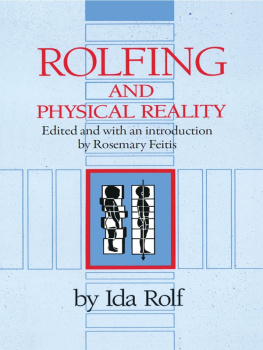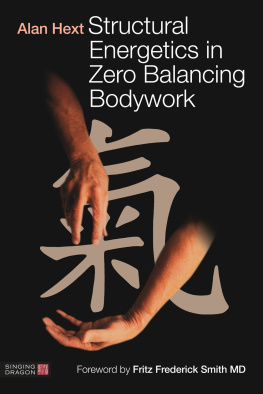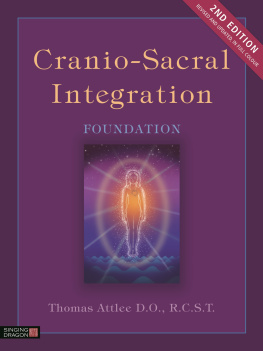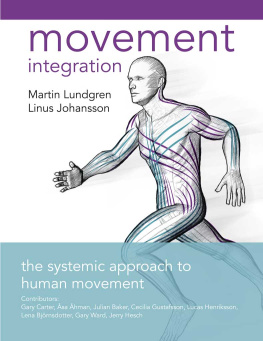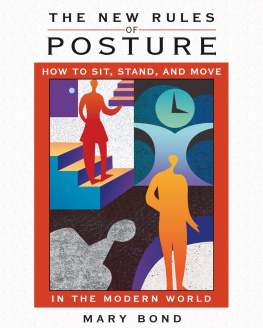
Ida P. Rolf
ROLFING
Reestablishing the Natural Alignment
and Structural Integration of the Human Body
for Vitality and Well-being
Ida P. Rolf, Ph.D.
Illustrations by John Lodge, M.A.
Photographs by Ron Thompson

Healing Arts Press
Rochester, Vermont
To the many people who helped carry the load, and to Marianne McDonald, who made the load so much easier to carry.
Contents
CHAPTERS
Foreword
The writing of this book has extended over four yearsfour years of the odd weekend, the in-between couple of months stolen from a heavy schedule of teaching and lecturing, traveling and treatments. The perceptive will notice that it changes pace and level from time to time, the influence of time and discussions as the circle of rolfing has widened, the result of reflection on the questions of students. The book is intended for two types of readers: the interested but untrained layman and the professional wanting technical information. We have attempted to marry these two levels of complexity, chiefly through the medium of the illustrations and their captions, which often have more technical information than the text.
Structural Integration is a statement of a point of view. Although we have tried to retain a sense of how Structural Integration fits with traditional ways of seeing the body, the main effort has been to unfold its ideas and implications in the light of our experience. The technique of Structural Integration deals primarily with the physical man; in practice, considerations of the physical are inseparable from considerations of the psychological.
Many will read this book hoping that it will answer the question, What is rolfing? It does, of course, answer that question, but perhaps not in the expected form. The book is a demonstration of the principles of the body, the manner in which it is made, and how this creature can change. The technique of Structural Integration is a conversion of these ideas into a therapeutic tool. The technique itself involves a ten-hour cycle of deep manual intervention in the elastic soft tissue structure (myofascia) of the body. The goal of this treatment is balance of the body in the gravity field; the principle of the treatment is, in brief, that if tissue is restrained, and balanced movement demanded at a nearby joint, tissue and joint will relocate in a more appropriate equilibrium.
This is a simplified statement; the reality is more complex both in practice and in effect. We have made an effort to give no helpful hints to those who would enjoy a little home experimentation. The technique of Structural Integration is powerful, and the resultant changes are far-reaching. As practitioners, we do not aim for change alone; we wish to induce change toward balance. Change without balance can be destructive. Experience has taught us that recognition of balance and understanding its many ramifications are subtle arts and long-term disciplines. Balance in the body does not reveal itself to the dilettante; it is a matter of intuition, experience, knowledge, and study.
Structural Integration does not cure symptoms. In fact, as practitioners we refuse to consider or diagnose symptoms except to investigate possible reasons for postponing our work (e.g., acute pain or illness of any kind, prolonged or massive medication or addiction). In addition to the obvious change in structure and stance, there are many other varied effects of rolfing. They are best summed up in the phrase I feel better (or lighter or easier). The added ease, the improved vitality are the result of greater balance; this does its own beneficial work on physical and psychological ills.
We are asked if rolfing is permanent. Rolfing enters into the bodys process and changes its course. Unless an accident intervenes, the body will continue along its new course. The effects of rolfing are not simply permanent, they are progressive.
We have included about a thousand photographs and drawings. The photographs give at least a static impression of the changes resulting from Structural Integration and illustrate definitions and comments on average structure, it should be noted that, with two exceptions, all photographs are of individuals processed by students during training classes. The two exceptions are practitioners of Structural Integration who received additional processing in the course of their training.
The anatomical drawings presented an unexpected and difficult problem. What was needed were drawings that would make graphic the anatomical balances discussed in the text. We soon discovered that the illustrations in standard anatomical books show no balance. Presumably, this is because the models used for these drawings are mostly hospital dissections, usually of bodies that suffered from disease and privation. John Lodges problem was to convert this textbook anatomy to balanced, living anatomy. A practitioner of Structural Integration, he accomplished this in drawings that are masterpieces of clarity and style, giving a new look at human anatomy and a new point of view for the student.
As we have discussed the ideas of this book with friends and associates, it has become obvious that one of its contributions will be to the concepts relating psyche and soma. It is an accepted truism that body and mind co-act, express each other, influence each other, yet there are few satisfying constructs defining the relation. Does psyche determine physiology, or is the opposite true? Where do the various schools of physical and psychological human improvement fit in? What could be called a valid definition of human improvement? We are adding to this discussion the evidence of experience with the ideas and the technique of Structural Integration. We hope the reader will gain objectivity from our experience and perhaps shift the level of his understanding.
Rosemary Feitis
New York, 1973
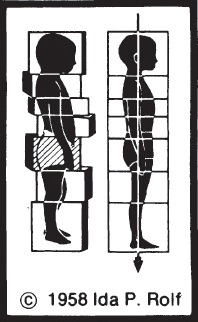
Structural Integration is now more popularly called rolfing, which is a trademark of the Rolf Institute, Box 1868, Boulder, Colorado 80306.
R.F.
1978
Preface
Literal Thorns in Literal Flesh
We are not stuff that abides,
but patterns that perpetuate themselves.
NORBERT WIENER
As in all matter organized into biological units, there is a pattern, an order, in human bodies. Humans can change toward orderliness, or they can change away from it. Human bodies do changeyour body can, any body can. We do not mean deteriorate or age in the commonly accepted sense. We mean that bodiesaverage physical bodies of flesh and bloodare amazingly plastic media, which can change quickly toward a structure that is more orderly and thus more economical in terms of energy.
Structural Integration is a system that induces change toward an ordered pattern. In general, it is a basic ten-hour cycle of treatment that balances myofascial relationships. The key to all life experience is movement; in the segmented human structure, movement is expressed through the joints. In humans, the myofascial component determines the adequacy of the joint. Thus, by changing the myofascia and bringing it toward the normal, the practitioner of Structural Integration evokes a more normal (in our sense of the word) movement. This book sets forth the mechanics of this process and, in our laboratory photographs, records its effects.
The possibility for this change derives from the structure of the body and its inherent message. It depends on the fact that a body is an entity, but not a unitary entity. Although the illusion of unity, of elementally, is created by the enwrapping fascia and skin, a human body is actually a complex, a consolidation of segments, the keystone of which is the pelvis. The perceptions, the responses, and the behavior of the integrated complex depend not on the individual units within the wrapping but on their relationship. An effective human being is a whole that is greater than the sum of its parts. Successful, meaningful integration depends on appropriate relationships in space among the components of the body.
Next page
